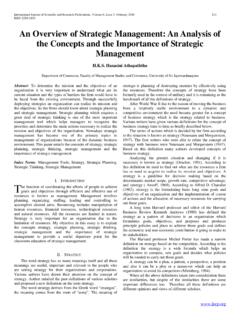Transcription of Effects of Strategic Planning on Organizational Growth. (A ...
1 international journal of Scientific and research Publications, Volume 5, Issue 9, September 2015 1 ISSN 2250-3153 Effects of Strategic Planning on Organizational growth . (A Case Study of Kenya Medical research Institute, Kemri) Odongo Melen Sophia *, Datche Owuor ** Jomo Kenyatta University of Agriculture and Technology, Box 81310-80100, Mombasa Abstract- This study s main objective was to determine the Effects of Strategic Planning activities on Organizational growth . Issues had been raised by employees that the Planning process tended to be inflexible and rigid since it operated in changing environment and poor adaptation to changing environment usually affected organization adversely. They perceived Strategic Planning process being unrealistic separated with actions which hindered growth , thus strategies not linked with actions. The Researcher in the study therefore sought to analyze the Effects of Strategic Planning on organization growth .
2 The specific objectives of the study was to establish the effect of setting objectives on organization growth ,to assess the effect of budgetary allocations on organization growth , to determine the effect of organization structure on organization growth and lastly to analyze the effect of performance review on organization growth . Descriptive research design was used which included questionnaires to be distributed and filled with various top managers, heads of department, middle level managers and general staff members of KEMRI. Target population in this research was Kenya Medical and research Institute Management. The target population was divided into various management groups including Heads of departments, middle level managers and general staff members. Stratified random sampling method was used.
3 The target population was two hundred employees. Stratified sampling method was used to draw the Sample size of 50 employees and data analyzed by use of Spss. The findings of the study revealed that Strategic Planning if well implemented in the organization is effective towards growth . Strategic Planning was appropriate, suitable, and reasonable and accepted to the organization. It clearly indicated that Strategic Planning exist at KEMRI and helped the organization evaluate its business by identifying its long term goals, objectives, organized workforce, monitor performance and allocating resources thus enhancing performance in terms of growth . The researcher recommendations are that set objectives be clear, precise and measurable, organizations to seek more funds which should be directed to research instead of administration, create structures that enable individual teams deal with specifications, Performance review process should enable the actual performance be easily measured and reviewed and in future KEMRI should strive to attain ISO standards to support continuing improvement.
4 Index Terms- Strategic Planning , Strategic management Performance review ,Organization growth I. INTRODUCTION Background of the Study ost firms desire growth in order to prosper and not just to survive. Organizational growth , however, means different things to different organizations. Indeed, there are many parameters a company can select to measure its growth . The most meaningful yardstick is one that shows progress with respect to an organization's stated goals. The ultimate goal of most companies is profit, so net profit, revenue, and other financial data are often utilized as "bottom-line" indications of growth . Other business owners, meanwhile, may use sales figures, number of employees, physical expansion, or other criteria to judge Organizational growth . Many firms desire growth because it is seen generally as a sign of success, progress.
5 Organizational growth is, in fact, used as one indicator of effectiveness for small and large businesses and is a fundamental concern of many practicing managers. (Cole,2002) Ultimately, success and growth of an organization will be gauged by how well a firm does relative to the goals it has set for itself. Strategic Planning is a key driver of Organizational growth , Since it has to emerge as a Strategic business partner helping the top management build an organization that is good not just for today, but for tomorrow and beyond. It is now working with the top management to propel the organization forward. Strategic Planning should be reviewed and we stopped looking at what is happening in other strategies and start looking at best Strategic Planning practices in large corporates. (Crosby, 1999). Caplow(2009) States that Problems encountered with organization growth are that business owners seeking to guide their organizations through periods of growth , whether that growth is dramatic or incremental often encounter difficulties.
6 After all, when a firm is small in size, the entrepreneur who founded it and usually serves as its primary Strategic and operational leaders can often easily direct and monitor the various aspects of daily business. In such environments, adds that the small business owner can also "understand a larger proportion of the relationships subordinates have with each other and with outsiders. Organizational growth , however, brings with it an inevitable dilution of that "hands-on" capability, while the complexity of various Organizational tasks simultaneously increases. "As the organization grows," said Caplow, "control becomes more complex by the mere accretion of numbers. There are ways of reducing the complexity by delegating responsibility. M international journal of Scientific and research Publications, Volume 5, Issue 9, September 2015 2 ISSN 2250-3153 According to Crosby (1999), Organizational growth also triggers an almost inevitable "diminution of consensus about Organizational goals.
7 " He attributed this "in part to the inherent difficulty of getting a larger number of people who know each other less well to agree about anything, in part to the importation of new people and ideas, but mostly to the brute fact that as an organization grows, its relationships to its members and to the environment necessarily change. Caplow,(2009) points out that such growth can be particularly disorienting for employee and owner alike: "often the people involved may not realize that anything significant has occurred until they discover by experience that their familiar procedures no longer work and that their familiar routines have been bizarrely transformed .Business owners, then, face a dizzying array of Organizational elements that have to be revised in accordance with changing realities. Maintaining effective methods of communications with and between employees and departments, for example, become ever more important as the firm grows.
8 Similarly, good Strategic Planning practices have to be implemented and maintained. Establishing and improving standard practices is often a key element of Organizational growth as well. Indeed, a large business that undergoes a significant burst of growth will find its operations transformed in any number of ways. And often, it will be the owner's advance Strategic Planning and management skills that will determine whether that growth is sustained, or whether internal constraints rein in that growth prematurely. Strategic Planning has been defined as the process of formulating, implementing and evaluating business strategies to achieve future objectives. Formal Strategic Planning began in the 1950 s in the United States of America with leading authorities being Drucker.(Drucker,1970). Ansoff (2007) viewed strategy Planning as the common thread in an Organization s business growth and the product scope of an organization.
9 All managers are involved in Planning but the nature of policies and plans set out by supervisors will vary with each manager s authority. While senior executives plan the direction of the organization, managers at various levels prepare plans for their own section which are part of the overall aims of the organization. Strategic Planning involves selecting enterprise goals and department objectives, then finding ways of achieving them. Plans depend upon the existence of alternatives and decisions have to be made regarding what to do, how to do it, when to do it and by whom it is to be done. A plan is a pre determined course of action which helps to provide purpose and direction for members of an organization. Strategic Planning are general and take place at a higher level in the organization and usually have a longer time horizon ranging from three to five years or more with annual updates when need be.
10 (Kreither,2006). To develop a Strategic plan, the plan should contain statement of organization mission and goals, strategies for obtaining and utilizing the necessary technological, marketing, and financial and human resources to achieve organization goals. Strategies for manufacturing process and conducting research and development and utilizing organization and employee competencies. The evolution of the field of Strategic Planning since its inception has been impressive. From its humble beginnings as the limited content of a capstone general management course in the business school curriculum, Strategic management is now a firmly established field in the study of business and organizations. During a relatively short period of time, this field has witnessed a significant growth on organizations.














